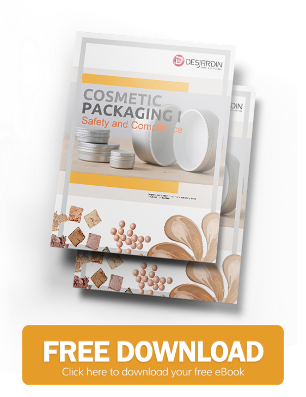New millennium manufacturing and packaging go hand in hand with sustainability. Tinplate and aluminum containers are both eco-friendly and can be recycled, which is why the demand for these materials continues to grow in the cosmetic industry. Here's a deeper look at why tinplate and aluminum containers are useful and favored for packaging for beauty products.
Tinplate and Aluminum Formats
The cosmetic industry gravitates toward tinplate and aluminum containers for a wide variety of reasons, due to a diversity of applications. Part of the appeal is that these metals can be easily customized to fit the imagination and needs of marketers. Another reason is that both metals can be customized to accommodate whatever concepts the company has about labelling. Due to the flexible nature of the materials, they can be mass produced quickly, efficiently and affordably.
Containers can take on a multitude of shapes and sizes, since the metals are easy to cut and bend in the manufacturing process. When the company needs a reclosable bag, plug-in-cap and resealable lid among many other possibilities, tinplate containers can be recycled over and over. Here are some common tin formats for cosmetic products:
- custom design
- seamless tins
- slip cover aluminum cans
- screw lid aluminum cans
- perfume tin with transparent lids
- aftershave containers
- hair care presentation tins
- round nail care tins
A key reason why both tin and aluminum are popular packing material choices is that they are both nearly tamper-proof. Even though no package is completely free of nefarious individuals breaching the closures, it is very difficult for someone to sneak into a store and open an aluminum or tin can without being noticed. Plastic bags or cardboard boxes, on the other hand, are more easily torn open, even in the shipping process. In that sense, tinplate and aluminum containers help extend the shelf life of a product and are less likely to create losses for vendors.
How Product Shape Affects the Environment
Products that come in liquid or powder form can be packaged in many more ways than more solid materials that limit the way they can be packaged. Seamless tins, for example, are effective for soft products such as fluids. The reason the shape of the packaging affects the environment in the production process is that cutting materials into shapes inevitably means the excess material will become waste, unless it can be recycled as scrap for other purposes.
Aluminum Sustainability
 Unlike plastic, which degrades over time, aluminum can be melted down and reused over and over indefinitely, whether it is used for cans or other formats. Due to the material's lightweight properties, it can be converted to huge thin sheets that are easy to manipulate into any shapes imaginable. Cylinder shapes for aluminum bottles and cans are among the most common for this process.
Unlike plastic, which degrades over time, aluminum can be melted down and reused over and over indefinitely, whether it is used for cans or other formats. Due to the material's lightweight properties, it can be converted to huge thin sheets that are easy to manipulate into any shapes imaginable. Cylinder shapes for aluminum bottles and cans are among the most common for this process.
To visualize why aluminum is so efficient, think of a giant sheet of aluminum weighing 9 metric tons but is as thin as construction paper. Such a roll can generate up to 3 million cans. Using a printer, the aluminum sheet feeds into a press that punches round shapes to make discs that are bent into cups that form the bottom of cans. The excess sheet is sent back to a factory as scrap material and recycled into new rolls.
After the cups are fed into a machine that generates bodies for cans, they are cleaned and dried. The cans are then coated, printed and varnished. A modern printer can produce 1,800 cans per minute. Following other cleaning treatments, necks and tops are added to the cans with other specialized equipment. Many manufacturers are turning to this more efficient eco-friendly "virtual factory" concept.
Trends In Aluminum Packaging
 In recent decades the Aluminum Association has been tracking the recycling rates of aluminum cans, which it reported in 2015 as having the highest recycling rate for containers in the beverage industry. Of course, the cosmetic industry doesn't sell beverages, but it can still learn from this study about sustainability. The report found that consumers, for example, appreciate aluminum for its lightweight, unbreakable and portable qualities. Since travelers often bring cosmetics with them on trips to beaches, sporting events and other outdoor venues, this data is valuable information for any industry looking to capitalize on eco-friendly solutions.
In recent decades the Aluminum Association has been tracking the recycling rates of aluminum cans, which it reported in 2015 as having the highest recycling rate for containers in the beverage industry. Of course, the cosmetic industry doesn't sell beverages, but it can still learn from this study about sustainability. The report found that consumers, for example, appreciate aluminum for its lightweight, unbreakable and portable qualities. Since travelers often bring cosmetics with them on trips to beaches, sporting events and other outdoor venues, this data is valuable information for any industry looking to capitalize on eco-friendly solutions.
From an economic perspective, the recycle value per ton of aluminum is over three times greater than other materials such as plastic or glass. Furthermore, in 2014 the recycle rate of aluminum cans was 56.7%, which was 12% higher than at the start of the decade. Meanwhile, the recycling rates of glass and plastic bottles was around 35%. About 70% of aluminum can content comes from recycled material on average, compared with the EPA's estimate that only 23% of glass bottles and 3% of plastic bottles are comprised of recycled material.
Another fascinating revelation from the study is that the average weight of aluminum cans is now 38% less than in 1972. Since typical aluminum cans are over 15 times lighter than 12 ounce glass bottles, it allows companies to package more product using less material. Since 2012, the aluminum can recycling rate has maintained historic high levels. The cosmetic industry can use this data and apply it to tinplate and aluminum containers as part of its sustainability awareness campaigns.
 Aluminum Foil Convenience
Aluminum Foil Convenience
Even though aluminum is easy to recycle, aluminum foil is more complex for reuse, since it involves the extra step of applying pinholes to thin sheets. Other than that, it's a useful material for preserving fresh fruits, vegetables, meats and other food items, as foil can be placed tightly over many different containers. This quality helps protect food from microorganisms, moisture, air, odors and light. Foil is also available in a wide selection of sheet thickness.
Since certain foods like produce are more healthy when they are fresh, many people discard excess food after a few weeks, but foil helps reduce food waste. Tinplate and aluminum containers offer even longer preservation, making them more eco-friendly in the long run.
Long Lasting Cosmetic Gifts
Part of the charm of cosmetic gifts that goes along with sustainability is that the containers can be square, round or any attractive shape and look worth preserving. Even when the cosmetic product has been completely consumed, the empty tinplate and aluminum containers can be saved as token reminders of how it's the thought that counts more than the gift itself.
So instead of disposing the item, environmentally-conscious people hang on to containers, perhaps even for convenience to store small items or to just keep to evoke pleasant memories.
Why Tinplate Lives On
Tinplating, which involves coating iron or steel with tin, used to be more common for manufacturing kitchenware like pots and pans. It is now mostly used for making tin cans due to the following factors:
- low toxicity
- corrosion resistant
- prevents rust
- production efficiency
- easy to recycle
 As far as environmental impact, the recycle rate of tinplate has grown exponentially in recent decades. According to a report from the Association of European Producers of Steel for Packaging (APEAL), the recycle rate of tinplate increased from 25% in 1991 to 74% in 2012. Tinplate can be recycled multiple times without any loss in its protective properties.
As far as environmental impact, the recycle rate of tinplate has grown exponentially in recent decades. According to a report from the Association of European Producers of Steel for Packaging (APEAL), the recycle rate of tinplate increased from 25% in 1991 to 74% in 2012. Tinplate can be recycled multiple times without any loss in its protective properties.
Tin is favored by food packers because it preserves food well, protecting perishable items from gas, water vapor, light and odors. Like aluminum, it is also easy to form into multiple shapes, making tinplate and aluminum containers ideal for a wide variety of commodities. That's why it's used for drinks, food, candy, powders, aerosols and popular mass-produced items. The tinplate process utilizes lacquers, which provide a stable shield between the product and steel. Like aluminum, tin is easy to ship and store due to its lightweight.
An alternative to tinplate and aluminum containers is tin-free steel, since it is a highly useful coating for metal. It enables labels and and graphical decoration to be added to the cans effectively. Additionally, tin-free steel costs less than tin, which is cheaper than aluminum.
Future of Sustainable Packaging
Sustainable packaging will continue to evolve steadily, as consumers are becoming increasingly more aware of environmental safety. Since packaging represents the first experience consumers often have with products, it's important for cosmetic companies to take this transition to green thinking seriously. Regardless of how the product is made or what it contains, eco-friendly packaging sets the tone for a brand that people can trust for taking the initiative on helping protect the planet.
In that sense, not only does eco-friendly packaging help build loyalty, it provides a competitive edge. It can help sway consumer purchasing decisions when price and quality are equal with competitors. Ultimately, sustainability can be achieved from various steps of the production cycle, using solar or wind powered equipment, as well as selection of eco-friendly materials for product substances as well as labels and containers.
Disclaimer:
The postings in this blog section do not necessarily represent Desjardin's positions, strategies or opinions.
References and Further Reading
- More posts on Cosmetic Packaging, by Alex Cosper and Dawn M. Turner
- Is It a Cosmetic, a Drug, or Both? (2016), by the U.S. Food and Drug Administration
- Regulation (EC) No ´1223/2009 on Cosmetic Products (2009), The European Parliament the the European Council
- ISO 22715:2006: Cosmetics -- Packaging and labelling (2006), International Organization for Standardization
- 4 Tips for Researching and Finding Wholesale Suppliers (2012), US Small Business Association
- 13 Tips for Negotiating with Suppliers (2012), Inc
- Supplier Selection (2009), Damian Bell






